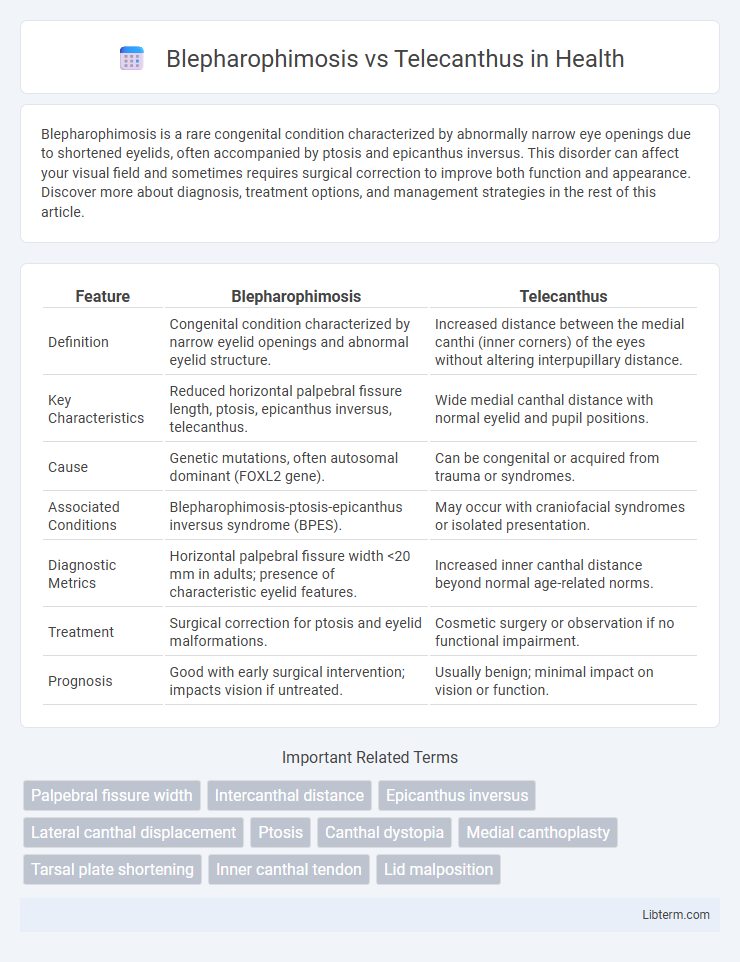Blepharophimosis is a rare congenital condition characterized by abnormally narrow eye openings due to shortened eyelids, often accompanied by ptosis and epicanthus inversus. This disorder can affect your visual field and sometimes requires surgical correction to improve both function and appearance. Discover more about diagnosis, treatment options, and management strategies in the rest of this article.
Table of Comparison
| Feature | Blepharophimosis | Telecanthus |
|---|---|---|
| Definition | Congenital condition characterized by narrow eyelid openings and abnormal eyelid structure. | Increased distance between the medial canthi (inner corners) of the eyes without altering interpupillary distance. |
| Key Characteristics | Reduced horizontal palpebral fissure length, ptosis, epicanthus inversus, telecanthus. | Wide medial canthal distance with normal eyelid and pupil positions. |
| Cause | Genetic mutations, often autosomal dominant (FOXL2 gene). | Can be congenital or acquired from trauma or syndromes. |
| Associated Conditions | Blepharophimosis-ptosis-epicanthus inversus syndrome (BPES). | May occur with craniofacial syndromes or isolated presentation. |
| Diagnostic Metrics | Horizontal palpebral fissure width <20 mm in adults; presence of characteristic eyelid features. | Increased inner canthal distance beyond normal age-related norms. |
| Treatment | Surgical correction for ptosis and eyelid malformations. | Cosmetic surgery or observation if no functional impairment. |
| Prognosis | Good with early surgical intervention; impacts vision if untreated. | Usually benign; minimal impact on vision or function. |
Introduction to Blepharophimosis and Telecanthus
Blepharophimosis is a rare congenital condition characterized by the narrowing of the horizontal palpebral fissures, resulting in a reduced eye opening. Telecanthus refers to an increased distance between the medial canthi of the eyes while the interpupillary distance remains normal, often seen in various craniofacial syndromes. Both conditions affect eyelid anatomy but differ in their clinical presentation and underlying causes.
Defining Blepharophimosis
Blepharophimosis is a congenital condition characterized by abnormally narrow horizontal palpebral fissures, resulting in consistently reduced eyelid opening. This condition often presents with ptosis, epicanthus inversus, and telecanthus, which refers specifically to an increased distance between the medial canthi without affecting the interpupillary distance. Differentiation between blepharophimosis and isolated telecanthus is essential for accurate diagnosis and targeted surgical intervention.
Understanding Telecanthus
Telecanthus is characterized by an increased distance between the medial canthi of the eyes, while the interpupillary distance remains normal, distinguishing it from blepharophimosis which involves narrowing of the entire horizontal palpebral fissure. Telecanthus often occurs in genetic conditions like Waardenburg syndrome and can be measured using inner canthal distance metrics. Accurate diagnosis of telecanthus is essential for proper surgical planning in craniofacial reconstructive procedures.
Key Anatomical Differences
Blepharophimosis is characterized by a reduced horizontal palpebral fissure length, causing the eyelids to appear abnormally narrow, whereas Telecanthus involves an increased distance between the medial canthi without affecting the eyelid fissure length. The interpupillary distance remains normal in Telecanthus, but is often decreased in Blepharophimosis due to the narrowed eyelid opening. These distinct anatomical differences are crucial for accurate diagnosis and appropriate management of each condition.
Clinical Features and Symptoms
Blepharophimosis is characterized by a decreased horizontal eyelid fissure length, resulting in narrowed palpebral openings, often accompanied by ptosis and epicanthus inversus. Telecanthus involves an increased distance between the medial canthi without affecting the interpupillary distance, leading to a widened appearance of the nasal bridge. Clinically, blepharophimosis presents with limited eyelid movement and visual axis obstruction, whereas telecanthus primarily affects the cosmetic appearance without significant functional impairment.
Causes and Risk Factors
Blepharophimosis is primarily caused by mutations in the FOXL2 gene, often inherited in an autosomal dominant pattern, leading to developmental abnormalities in the eyelid muscles and connective tissues. Telecanthus results from abnormal nasal bone development or craniofacial syndromes such as Waardenburg or Down syndrome, causing increased distance between the medial canthi without affecting the inter-pupillary distance. Risk factors for blepharophimosis include family history and genetic predisposition, while telecanthus is linked to congenital syndromes and craniofacial anomalies.
Diagnostic Criteria and Examination
Blepharophimosis is characterized by a narrowing of the horizontal palpebral fissure, often accompanied by ptosis and epicanthus inversus, while telecanthus specifically refers to increased distance between the medial canthi without affecting the interpupillary distance. Diagnostic criteria for blepharophimosis include measurement of reduced horizontal palpebral fissure length below age-appropriate norms, presence of eyelid malformations, and genetic testing for FOXL2 mutations. Examination for telecanthus involves precise measurement of the inner intercanthal distance exceeding normative data, evaluation of lacrimal apparatus positioning, and exclusion of orbital structural anomalies via imaging studies.
Associated Syndromes and Conditions
Blepharophimosis is frequently associated with Blepharophimosis Ptosis Epicanthus Inversus Syndrome (BPES), characterized by eyelid malformations along with possible premature ovarian failure. Telecanthus is commonly linked to Waardenburg syndrome, which presents with auditory defects, pigmentary abnormalities, and telecanthus as a key facial feature. Both conditions may coexist in syndromic presentations like Noonan syndrome, involving multiple congenital anomalies, including cardiac defects and craniofacial dysmorphisms.
Treatment and Management Options
Blepharophimosis treatment often involves staged surgical procedures to correct eyelid malformations, including ptosis repair and horizontal eyelid widening, enhancing both function and appearance. Telecanthus management typically requires surgical medial canthoplasty to reposition the medial canthal tendons, improving intercanthal distance and eyelid symmetry. Both conditions may benefit from multidisciplinary care involving ophthalmologists and plastic surgeons to optimize functional and aesthetic outcomes.
Prognosis and Long-term Outcomes
Blepharophimosis typically presents with a narrower horizontal eyelid opening affecting visual development, often requiring early surgical intervention to prevent amblyopia and improve visual function. Telecanthus, characterized by an increased distance between the medial canthi without affecting eyelid morphology, generally has a better prognosis since it rarely impacts vision or ocular function. Long-term outcomes in blepharophimosis depend on the timing and success of corrective surgeries, whereas telecanthus often requires only cosmetic correction with minimal functional concerns.
Blepharophimosis Infographic

 libterm.com
libterm.com